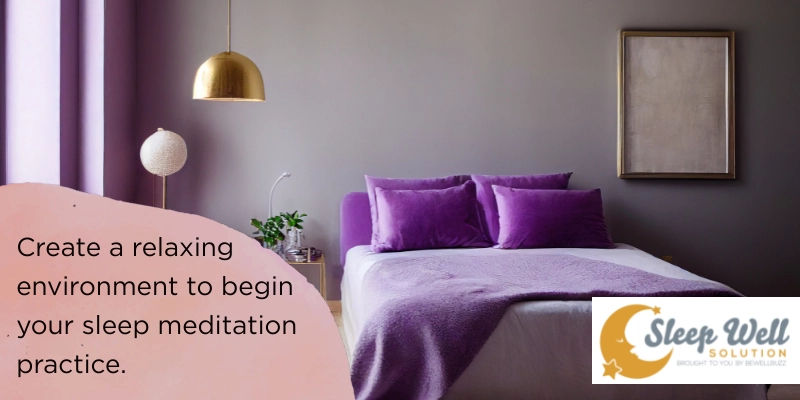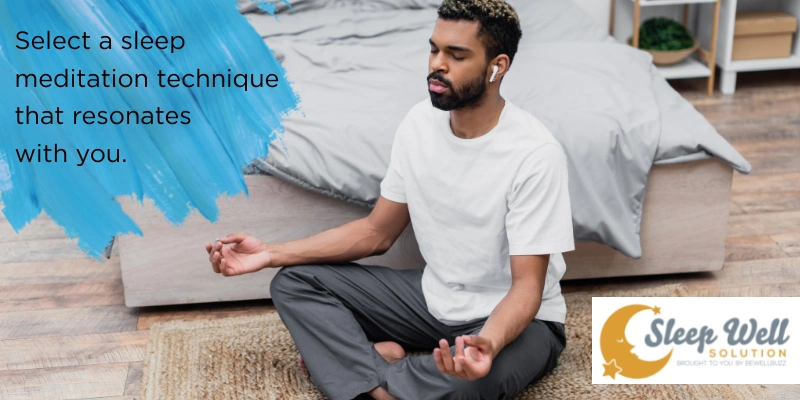The Ultimate Guide to Sleep Meditation: Techniques for a Deeper Sleep

Sleep meditation is a powerful practice that can help you achieve a deeper and more restful sleep. It involves calming the mind and body before bedtime, allowing you to let go of the day’s stresses and worries. By incorporating sleep meditation into your nightly routine, you can experience improved sleep quality and wake up feeling refreshed and rejuvenated. Here is the ultimate guide to sleep meditation, complete with techniques to help you achieve a deeper sleep:
How to Begin Your Sleep Meditation Practice
Here are the steps to help you prepare for a successful sleep meditation session:
1. Create a Relaxing Environment
Preparing for sleep meditation involves creating a calming, and relaxing environment in your bedroom and adopting practices that signal your body and mind that it’s time to wind down. Dim the lights or use soft, warm lighting to set a relaxing ambiance. Consider using essential oils or candles with soothing scents like lavender or chamomile to promote relaxation. Lie down on your back or find a comfortable seated position. Use pillows or blankets for extra comfort.
Remove any distractions such as electronic devices and clutter. Minimize exposure to screens such as phones, tablets, or laptops at least an hour before bedtime. If possible, use earplugs or white noise machines to block out any disruptive sounds.
2. Craft a Consistent Bedtime Routine
Establishing a consistent bedtime routine can signal to your body and mind that it is time to sleep. Incorporate calming techniques into your routine, such as reading a book, taking a warm bath, or practicing gentle stretching exercises. Consistency is key to creating a peaceful and effective bedtime ritual. Establishing a bedtime routine tailored to your preferences and needs can significantly improve the effectiveness of your sleep meditation techniques and thus the quality and quantity of your sleep.
3. Practice Relaxation Techniques
Deep Breathing: Deep restful sleep is a fundamental technique in sleep meditation. Sit or lie down comfortably, close your eyes, and take slow, deep breaths to calm your nervous system. Inhale deeply through your nose, allowing your belly to rise, and exhale slowly through your mouth. Focus your attention on your breath, letting go of any racing thoughts or tension in your body with each exhale.
Progressive Muscle Relaxation: Progressive muscle relaxation is a technique that involves tensing and then releasing each muscle group in your body, one at a time. Starting from your toes and moving upwards, tighten the muscles in each area for a few seconds, and then release the tension. This practice helps to release physical tension and prepares your body for overall relaxation.
4. Select a Sleep Meditation Technique
Discovering the most suitable sleep meditation method for you involves a bit of exploration and self-awareness. Consider any previous encounters with meditation or relaxation techniques. Did any specific method resonate with you or help you relax more effectively? Determine whether you prefer guided sessions with verbal instructions, soothing music or sounds, visualizations, or other methods. Pay attention to the duration of the meditation sessions. Some individuals find shorter sessions more suitable for bedtime, while others benefit from longer practices. Assess the quality of your sleep after trying different techniques. Finally, trust your intuition. If a particular technique feels calming, and relaxing and brings a sense of ease, it might be the right fit for you.
5. Wind Down After Sleep Meditation
After the meditation session, take your time to transition back to your surroundings slowly. Avoid sudden movements and allow yourself to bask in the relaxed state you’ve achieved. Refrain from consuming caffeine or engaging in stimulating activities right before bedtime.
Sleep Meditation Techniques for Deeper Sleep
1. The Power of Guided Imagery: Unlock Tranquil Nights
Dive into a serene world of imagery. Guided imagery is a technique that involves visualizing calming and peaceful scenes in your mind. It can help redirect your focus away from racing thoughts and induce a state of relaxation. Picture yourself in a tranquil oasis, surrounded by gentle whispers of nature. Guided imagery takes you on a journey, soothing your mind, and guiding you to a restful slumber.
You can listen to guided meditation recordings or create your own imagery by imagining yourself in a serene environment, such as a beach or a peaceful garden. Engage all your senses to enhance the experience.
2. Soothing Soundscapes: Harnessing the Harmony of Sleep
Listen to the symphony of tranquility. This sleep meditation technique leverages the power of sound to create a tranquil environment conducive to rest. Discover the therapeutic influence of calming sounds – ocean waves, rainfall, white noise, forest sounds, or celestial melodies. Experiment with different sounds or combinations to identify what works best for you. Some people find solace in nature sounds, while others prefer gentle instrumental music.
Play these sounds softly in the background and integrate these soothing soundscapes into your meditation or relaxation routine. Focus on the sounds, allowing them to guide your mind toward a state of tranquility. Let these harmonious rhythms lull you into a deeper, more rejuvenating sleep.
3. Mindfulness Meditation: Embrace Present Peace
Embrace the present moment. Mindfulness meditation involves focusing your attention on the present moment without judgment. Embrace the present moment. As you lie in bed, bring your awareness to your body, the sensations, and the environment around you. Notice the feeling of the sheets against your skin, the sounds in the room, and the gentle rhythm of your breath. Whenever your mind wanders, gently bring it back to the present moment without getting caught up in thoughts.
Engaging in mindfulness meditation cultivates awareness of thoughts and sensations. By acknowledging the here and now, you invite calmness and tranquility into your sleep routine.
4. Breathing Techniques: The Gateway to Serenity
Master the art of conscious breathing. Utilize specific breathing exercises to calm the mind, relax the body, and induce a state of tranquility. These techniques leverage the power of breath to regulate the body’s stress response and promote relaxation. Inhale serenity, exhale stress. Explore various breathing exercises designed to relax your mind and body, paving the way to a profoundly restful sleep. Sit or lie down in a comfortable position. Close your eyes if it helps you focus. Select a specific breathing pattern or technique that resonates with you and integrate it into your bedtime routine to signal your body that it’s time to relax and prepare for sleep.
Controlled breathing activates the body’s relaxation response, reducing stress hormones like cortisol and promoting a sense of calm. With breathing techniques, you can harness the power of breath to cultivate serenity and pave the way for a more peaceful state of mind and deeper sleep.
5. Sleep Meditation Apps: Technology for Tranquility
Harness the convenience of technology. Utilize mobile applications specifically designed to facilitate sleep meditation, relaxation, and overall well-being. These apps offer a wide range of features, including guided meditations, soothing sounds, sleep stories, and relaxation exercises, accessible at your fingertips. Most apps are designed with intuitive interfaces, making them easy to navigate and use, even for beginners, and are available on various platforms like smartphones, tablets, or smartwatches, ensuring accessibility wherever you go. Use the structure and guidance sleep meditation apps provide to establish a regular meditation practice.
Each technique offers a unique pathway to a deeper, more fulfilling sleep. Experiment, explore, and find the method that resonates best with you, paving the way to nights of tranquil rest and rejuvenation.
Overcoming Common Obstacles to Sleep Meditation Practice
Practicing sleep meditation can encounter various obstacles, but with persistence and the right approach, you can overcome these challenges. Here are common obstacles and strategies to address them:
Racing Thoughts or Restlessness
Obstacles: Difficulty quieting the mind or feeling restless while attempting to relax. This barrage of thoughts and restlessness can disrupt the meditation process.
Solutions:
- Practice patience and acknowledge that it’s normal for thoughts to arise. Instead of fighting them, gently guide your focus back to the meditation.
- Gradually build a meditation practice during non-sleep hours.
- Try using guided meditations specifically designed to address racing thoughts or restlessness.
- Try techniques such as focusing on breathing or body sensations.
- Engage in progressive muscle relaxation or deep breathing exercises to help calm the body and mind.
Distractions, External Noise, and Discomfort
Obstacles: Interruptions from external noises, discomfort, or distractions.
Solutions:
- Use earplugs, white noise machines, or soothing music to drown out external disturbances.
- Create a dedicated space that minimizes potential distractions and promotes relaxation.
- Experiment with different meditation positions or use pillows and blankets for added comfort.
- Focus on the sensations of relaxation during the practice rather than discomfort.
- Accept distractions without judgment and gently bring your focus back to your meditation practice.
- Utilize guided meditations specifically designed for sleep that help divert attention from distractions.
Lack of Consistency or Time
Obstacles: Finding it challenging to maintain a regular meditation routine or feeling pressed for time due to a busy lifestyle or lack of motivation.
Solutions:
- Start with shorter sessions and gradually increase the duration as you become more comfortable.
- Incorporate meditation into your bedtime routine consistently, even if it’s just for a few minutes each night. Establish a routine and set a fixed time for sleep meditation, using apps or reminders.
- Prioritize your sleep and relaxation by carving out time, even amidst a busy schedule. Recognize the benefits of regular practice.
Impatience or High Expectations
Obstacles: Expecting immediate results or feeling frustrated if relaxation doesn’t come quickly.
Solutions:
- Embrace the process and understand that relaxation may take time to achieve.
- Release expectations and approach each session without judgment.
- Celebrate small improvements or moments of relaxation, acknowledging the progress made.
Conclusion
By incorporating sleep meditation techniques into your nightly routine, you can enhance your ability to achieve a deeper and more restful sleep. Remember to create a relaxing environment, practice deep breathing, try progressive muscle relaxation, engage in guided imagery or mindfulness meditation, and establish a consistent bedtime routine.
It’s important to know that everyone’s experience with sleep meditation may differ, and it may take time to find the right approach. Experiment with different techniques to find what works best for you and enjoy the tranquility it brings to your bedtime ritual. With dedication and practice, sleep meditation can become an invaluable tool for improving your sleep quality and overall well-being.











